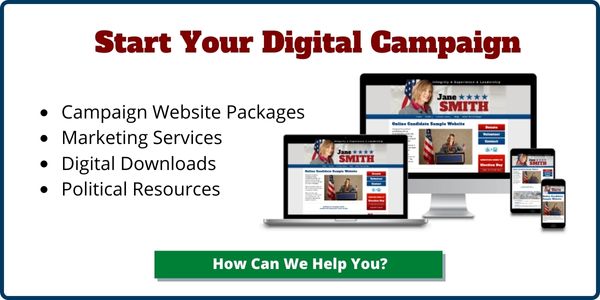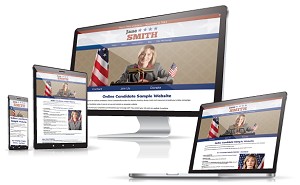Maximize Your Funds: Must-Know Political Fundraising FAQs
The pursuit of public office is often tied greatly to the pursuit of raising money. If you are a political candidate today, you’ll need to raise money to mount an effective campaign. And if you’re new to the process, you’ll want to get up to speed quickly and not wait until the thick of election season.
Here are frequently asked questions about about political campaign fundraising.
Key takeaways:
- Choose a Secure, User-Friendly Donation Platform: Opt for a platform with strong security and easy integration with your campaign website.
- Optimize the Donation Page: Ensure simplicity and clarity on your donation page.
- Implement Structured Donation Levels: Offer varied suggested amounts and a custom donation option to encourage higher and more frequent contributions.
- Maximize Your Website for Fundraising: Use clear calls-to-action, engaging content, and a straightforward donation process.
- Integrate Fundraising Efforts: Your digital fundraising efforts should align with your campaign messaging.
- Use Storytelling and Personalization: Emotional storytelling and personalized communication helps connect with supporters.
- Comply with Legal Standards and Acknowledge Donations: Follow your local campaign finance laws and acknowledge every contribution.

Frequently asked questions about political campaign fundraising:
How do I set up a secure online donation platform?
To set up your campaign’s secure online donation platform, begin with a reputable service. Ensure it offers robust security, like SSL encryption and PCI compliance. The platform should integrate well with your website, providing a straightforward donation experience. Include various payment methods, catering to different donor preferences. Before launching, test everything to avoid any glitches when you start fundraising. Always comply with your local campaign finance laws, especially for collecting and reporting donor information.
Before you begin any campaign fundraising, you’ll need to establish a bank account for your organization. Then you can set up an online donation platform. Here’s how to do it effectively:
- Choose a Trusted Platform: Start by selecting a reputable donation platform. Look for services that specialize in political campaigns and feature security and reliability.
- Security is Key: It’s probably not even worth mentioning as every major platform provides robust security features. This includes SSL encryption for data protection and PCI compliance to safeguard donors’ financial information.
- Seamless Website Integration: The donation platform should integrate smoothly with your campaign’s website. Whether embedded or link as a separate donation page, it should match your site’s look and feel. A seamless experience is needed so donors don’t question why a donation page looks completely different than the page they clicked from.
- User-Friendly Interface: Your donation process should be straightforward and user-friendly. A simple form with minimal required fields is best. Make sure you request all the donor information required by your local laws – and nothing more, if you can help it. A complicated process and too much information requests will discourage potential donors.
- Multiple Payment Options: Offer various payment methods like credit/debit cards, PayPal, and bank transfers. The more options you provide, the easier it is for donors to contribute. Again, this is mainly platform-specific.
- Compliance with Regulations: Make sure the platform complies with your local campaign finance laws. This includes features for collecting necessary donor information and facilitating reporting numbers. You’ll want to have simple reporting that’s easy to download.
- Test and Launch: Before going live, thoroughly test your donation process to ensure everything works from input to processing.
We’ve seen too many candidates not test their donation setup before asking for funds! It’s a bad situation when a candidate sends the wrong link via email or the processor won’t process the donation due to the account not being approved. Don’t let this happen to you!
“In all, just 158 American families had donated half of all the money to candidates on the ballot [in the 2016 election].” – Wildland: The Making of America’s Fury
Related: How Online Political Donations Work
How can I improve my donation page?
First, keep your donation page should have a clean layout without distracting elements, such as page navigation or other calls to action. Use direct language a simply “make the ask”. Emphasize your security and payment methods. You’ll want to have suggested donation amounts, and prepopulate the amount with an amount or selection that is above the lowest level. Done right, a your fundraising page can make donations easy, and hopefully encourage larger or repeat contributions.
Most of the following features are included with major political donation platforms:
- User-Friendly Design: Again, keep the page layout simple. Avoid asking for irrelevant information.
- Secure Payment Options: Offer multiple, secure payment methods. Trust is crucial for political donors, so highlight your security measures and privacy policies.
- Suggested Donation Amounts: Provide suggested amounts to help donors decide how much to give. Include an option for custom amounts for flexibility. Make sure the max donation amount does not exceed your maximum allowable contribution amount.
- Impact of Donations: State how the donations will be used in your political campaign. It may be to help the candidate or it may be for something more tangible, like additional advertising. People are more inclined to give when they know the specific impact of their contribution.
For Example: A mayoral candidate’s donation page could feature a progress bar showing fundraising goals, making the impact of donations visible. For a congressional run, a donation page might include a video message from the candidate discussing national issues and the help they need to win.
Can offering different donation levels increase contributions?
Structured donation levels can encourage donors to give more than they might have without any encouragement. Here’s how to implement your page for maximum contributions:
- Suggested Amounts: Offer a range of donation amounts to cover different financial levels. If your donor can contribute $1000, why limit the maximum contribution to $500?
- Custom Donation Option: Always include an option for donors to choose their own amount, as some may want to give more or less than the suggested levels.
- Additional Incentives: Consider offering small tokens of appreciation for different donation levels to encourage higher contributions. We don’t see this too often in smaller campaigns, but sometimes donor swag is offered for some state and congressional campaigns.
How can my campaign website help maximize fundraising?
Your campaign website is often the first point of contact for potential donors, so it’s crucial to make a strong, positive impression. Maximizing fundraising through your website is all about clarity and engagement. Here’s how to make it happen:
- Clear Call-to-Action: Use prominent, clear call-to-action buttons for donations. Place them in visible spots like the header, footer, or in the sidebar.
- Tell Your Story: People connect with stories. Tell yours. Share your campaign’s journey, your political vision, key political milestones, achievements, and how donations make a difference. Add a mix of text, images, and videos to improve your narrative.
- Provide Regular Updates: Keep your supporters informed about how their contributions are being used and the progress towards your fundraising goals. Transparency builds trust.
- Responsive Design: Many donors will visit your site from their mobile devices, so your website and donation forms should be mobile-friendly.
How can I integrate fundraising with other aspects of my website?
Here are some useful tips:
- Unified Messaging: Your fundraising appeals should be in line with your overall political campaign message.
- Strategic Placement of Donation Calls-to-Action: Incorporate donation buttons or links in key areas of your website. This makes it easy for supporters to donate from almost anywhere on your site.
- Content Synergy: Use your blog posts, news updates, and policy discussions to subtly lead into fundraising calls-to-action. For example, after discussing a particular political issue, link to and describe how supporter donations will help achieve these goals.
- Event Integration: If you’re hosting political events, whether virtual or in-person, make sure there’s an easy way for participants to donate. This could be through a link in a virtual event description or a QR code at a campaign rally or on a campaign brochure.
- Social Proof and Testimonials: Feature stories, testimonials, or quotes from supporters and influential figures in the political arena on your website. This display of support encourages others to contribute.
- Regular Updates: Keep your supporters informed about the progress of your political campaign. This transparency can motivate further donations and strengthen supporter trust.
“The money in politics is a cash cow for the media.” – Noam Chomsky
What types of content can I use to promote fundraising?
Diverse content can engage different segments of your audience. Consider these types:
- Videos: Short, impactful videos can effectively convey your message and emotionally engage viewers. Video can be located on a YouTube page, your social media accounts, and even embedded on your website.
- Blogs: Write about your campaign’s journey, achievements, and how donations are making a difference or needed in order to make a difference.
- Infographics: Use infographics and pictures to present data and progress in an easily digestible format. For example, many campaigns use ‘goal thermometers’ to visually display how much they have raised and now much more they need to reach their goal.
- Testimonials: Share stories and quotes from supporters or those who have benefited from your campaign. If you can, try to match your testimonials with the specific group you are looking to target.
Specific content ideas:
- City Council Campaign: Create blog posts about local community events and council meetings. They can show the candidate’s involvement and impact and can encourage donations.
- State Representative Campaign: Include infographics that show legislative progress and goals. This can help constituents visualize the impact of their support for the candidate.
Can social media enhance my fundraising efforts?
Absolutely! Social media can really amp up your fundraising. Social media platforms like Facebook, Instagram, and X/Twitter offer unique opportunities to connect with supporters, share your campaign’s story, and drive traffic to your donation page. Here’s how:
- Promote Your Donation Page: Regularly share the link to your donation page on your social media channels.
- Engaging Content: Create shareable content that resonates with your audience and encourages them to support your cause.
- Utilize Fundraising Tools: Many social platforms have built-in fundraising tools. Use them to direct traffic to your website.
- Interact with Your Audience: Engage with your followers. Respond to comments, share stories, and be active. This builds a community around the candidate and your political campaign.
Social outreach can amplify your fundraising efforts and help build a stronger online support.
What can make a fundraising message more compelling?
A compelling message not only informs but also inspires action, making it a critical component of successful fundraising. Here’s how to craft one:
- Add a Political Angle: Share real stories that illustrate the impact of your political policies. Personal anecdotes from voters and how they have benefited from the work of the candidate or campaign can be far more persuasive to others.
- Be Specific: Clearly articulate what the donations will achieve. Whether it’s funding a specific part of your campaign or supporting a broader goal, specificity can drive action.
- Authenticity: Be genuine in your messaging. Authenticity resonates and builds trust with voters and constituents.
- Visual Appeal: Use images and videos to complement and enhance your message. Visuals are powerful way to convey emotions and facts.
Fundraising Message Examples:
- School Board Candidate: This could include a message focusing on improving local education. It may feature compelling personal stories from students or teachers.
- Congressional Candidate: A narrative about national policy changes, backed by personal anecdotes from diverse constituents, can create a strong emotional appeal.
How can I use storytelling to boost online donations?
Storytelling is a powerful tool to reach, attract, and convince supporters to give. Here’s how storytelling can help:
- Emotional Connection: Share stories that create an emotional connection with your audience. Emotions can drive people to take action.
- Relatable Characters: Use real-life constituents in your stories. People relate to other people’s experiences and challenges, especially if the characters are like them.
- Clear Narrative: Have a clear beginning, middle, and end. This can be about how a person’s situation turned out due to your policies or intervention. A well-structured story is more engaging and memorable.
- Visual Elements: Incorporate photos or videos into your storytelling to enhance the impact.
What are some best practices for raising money through email?
Email remains a powerful fundraising medium, and it should not be underestimated. Here are some best practices to keep in mind:
- Segment Your List: Tailor your messages to donor behavior and preferences. Personalization can significantly increase engagement.
- Strong Subject Lines: Your subject line determines whether your email gets opened. Make it compelling and clear.
- Clear Call-to-Action: Include a direct and clear call-to-action in your emails, such as ‘Support our campaign’ or ‘Donate to our cause.’
- Track and Analyze: Use analytics to track open rates, click-through rates, and conversions. This data will help you refine your strategy.
How can I communicate urgent donation needs in my campaign messaging?
Communicating urgency can drive immediate action. This is especially effective as election day draws near, and you are starting to GOVT.
- Time-Sensitive Language: Use phrases like “Donate now,” “Time is running out,” or “Your immediate action is needed” to create a sense of urgency.
- Regular Updates: Keep your audience informed about how close you are to reaching your fundraising goals and deadlines.
- Immediate Impact: Explain how timely donations can make an immediate difference in your campaign.
- Visual Countdowns: Use countdown timers on your website or in emails to visually represent the urgency.
How can I attract first-time donors to give?
Everyone goes after donor with a history of political contributions, but attracting first-time donors will expand your support base. Here are some strategies:
- Engaging Content: Create content that resonates with potential donors, highlighting the importance and impact of their contribution.
- Simplified Donation Process: Make the donation process as easy as possible. A complicated process can deter first-time donors.
- Social Proof: Share stories and testimonials from other donors. This can build trust and encourage new donors to contribute.
- Outreach: Reach out to potential donors through various channels like social media, email, and community events.
What role do recurring donations play in campaign fundraising?
Recurring donations are a cornerstone of sustainable fundraising. Here’s their importance:
- Steady Income Stream: They provide a predictable income stream, allowing for better budgeting and planning.
- Builds Donor Relationships: Recurring donors are often more engaged and committed to your cause.
- Ease of Giving: Once set up, it’s easy for donors to continue their support without having to take additional steps.
- Focus on Retention: Encourage one-time donors to become recurring donors through follow-up communications and special incentives.
How should I handle and acknowledge small donations?
Every donation counts, and acknowledging small donations is key. Here’s how to do it:
- Thank You Messages: Send personalized thank you messages or emails to every donor, regardless of the donation size.
- Social Media Shoutouts: Recognize and thank small donors on your social media platforms.
- Create a Donor Community: Foster a sense of community among all donors, regardless of the donation size, through regular updates, exclusive content, or community events.
How can donor feedback to improve my fundraising strategy?
Leveraging donor feedback can help you refine and improve your fundraising approach.
- Act on Feedback: Be responsive to the feedback you receive. Make changes to your strategy or processes based on donor suggestions and concerns.
- Open Communication Channels: Create avenues for donors to easily provide feedback, such as through social media, email, or your website.
- Analyze Donation Trends: Look at your donation data to identify trends and patterns. This can provide indirect feedback on what’s working and what’s not.
How do I ensure my fundraising efforts are legally compliant?
Make sure all of your fundraising efforts maintain the integrity and legality of your campaign. Here are key steps to ensure legal compliance:
- Understand the Laws: Familiarize yourself with the campaign finance laws applicable in your area. These laws can vary significantly depending on the level of government (local, state, federal) and location.
- Use Compliant Platforms: Choose fundraising platforms that adhere to legal standards for political donations. This includes secure processing of contributions and proper recording of donor information. Good political fundraising platforms make it easy for your treasurer to download reports suitable for FEC filing.
- Transparent Record-Keeping: Maintain accurate and transparent records of all donations and expenditures. This is not only a legal requirement but also a practice that builds trust with your supporters.
- Regular Reporting: Submit any required financial reports to the appropriate regulatory bodies on time.
- Legal Consultation: Consider consulting with a legal expert specializing in campaign finance. This can help you navigate complex legal requirements and ensure full compliance.
- Educate Your Team: Make sure that everyone involved in your campaign, especially those handling fundraising and finances, is aware of the legal requirements and complies with them.
What are some common mistakes to avoid in online fundraising?
Here are some pitfalls to watch out for:
- Complicated Donation Process: A complex or lengthy donation process can deter potential donors. Ask for as little information as you legally need to complete the transaction.
- Lack of Personalization: Generic fundraising appeals may not resonate with potential donors. Personalize your request as much as possible to connect with your audience. This can include a drive for money to print another brochure, run more cable ads, purchase a billboard, and so on.
- Neglecting Donor Acknowledgment: Failing to promptly and properly thank donors can harm your relationship with them. Every donor, regardless of the amount contributed, should be acknowledged and appreciated.
- Inadequate Use of Data: Not using data to guide your fundraising strategy is a missed opportunity. Analyze donor behavior and preferences to tailor your approach.
- Failing to Properly Use Social Media: Social media is a powerful tool for fundraising. Not using it effectively can mean missing out on a wide audience and potential donations.
Related: Comparing Political Donation Platforms – Our Recommendations
Our book, Running for Office as an Online Candidate is designed packed with strategies for local political and issue-specific campaigns. It is available for download and in print from Amazon.com.
What Are The Basic Requirements To Run For Public Office?
Local government is the fundamental building block of our government structure. Local officials and agencies are in the best position to understand the needs of the constituents they serve, and actively work to solve their problems by improving infrastructure, education, and other key aspects of life.
Running for office is a great way to make a difference in your town, city, or county. If you are planning to run, then you need to prepare yourself by learning about the position you seek, getting your name out to the public, and learning how to build out a campaign organization.
But before you do all that, one of the first steps to run for elected office is to find out if you are qualified to be a candidate. This applies if you are running for council, mayor, sheriff, judge, state legislature, or even for a position on your local school board.
All elected positions have specific qualifications
To be eligible as a state, county or local political candidate, there are basic qualifications you’ll need to meet. These requirements are determined by the laws and regulations of your state and district.
There are three basic requirements to hold political office in the United States:
- You need to be a citizen.
- Be least 18 years old.
- Live in the district you want to represent.
These conditions will apply no matter your political party or even if you are a write-in candidate. In some states, you must be a resident of the district for at least one year or two years before the election.

Even local elections cost money. There’s no getting around that.
Local offices are generally the most affordable of all political offices. It is not uncommon for someone to run for local office with hardly any money at all. However, most candidates must raise funds to pay for their campaigns.
The cost of running a political campaign depends on the position sought, the number of people running for office, and how many votes are needed to win. A local election can usually cost anywhere from a few hundred dollars to a $1 million or more.
The 2021 Boston mayoral race was one of the most expensive races in American history, with candidates spending over $5 million combined. It’s a city, but still a local race.
Local races typically raise and spend far less than campaigns for a state or national office. Regardless, it is necessary to put together a budget and a strategy to raise money. Even if you don’t think you’ll need to spend too much, your opponent may be preparing otherwise…
Free Campaigning Tips: Subscribe for free guides and updates from Online Candidate.
You need time to prepare for your campaign
The process of political campaigning is not easy. Running for local office is not as difficult as running for a national office. The run time of the campaign varies depending on the type of position you are aiming to win, but it can be anywhere from one to two years.
You need enough time to prepare yourself, your family and to get the word out about your intentions.
Some years ago, we had a candidate run for village council. It was a small, local race that only lasted a month or two. A week before the election, the candidate was asked by a newspaper about where he stood on a major local issue. He said he ‘didn’t want to tip his hat’ too early. Because he waited so long to ramp up his candidacy, he never got the chance.
And he didn’t win the election.
Registering to run as a political candidate
Registering a campaign committee is the first official step to gaining access to the ballot for a primary or general election. This can be done through your local board of elections office.
Each office has different guidelines. Whether you are an experienced politician or just getting started, you and your team will need to follow any compliance rules. Contact your local board of elections for more information on how to get on the ballot.
A bank account and financial structure must be established
Almost every campaign is going to require money to be spent on advertising, staff, and other expenses. The first step to running for office is to have a dedicated campaign bank account. This account will allow you to take in money through donations and spend money during the election season.
You’ll need to put together a campaign team
Election campaigns need a diverse range of staff to be successful. They need people to arrange events, make phone calls, knock on doors, and raise money. Individual roles in include a treasurer, volunteer coordinator, communication director and various consultants.
Some positions on the team are more important than others. For example, a campaign manager is usually the most important person in charge of the campaign. They must make sure that everything is done on time and to plan.
The lack of a campaign manager can be a recipe for disaster. A well-run campaign needs a combination of organization, strategy, and execution. Without the right person in charge, even well-spoken candidates might find themselves in trouble.
Tip: In almost no circumstance should a political candidate act as their own campaign manager.
Start the campaigning process
Be informed and know your positions on the issues that are happening in your district. You should also know your district boundaries, and familiarize yourself with voting districts. There are many different viewpoints and opinions, so it is important to be aware of all sides as you develop your election platform.
Other questions
Are there legal or criminal background restrictions for running for public office?
Legal or criminal background restrictions vary by jurisdiction. Some areas disqualify candidates with felony convictions, while other may have less stringent criteria. You’ll need to check your local election laws for specific restrictions or details.
How does the political party system influence the process?
Navigating the political party system involves understanding local party dynamics. Candidates should research their party’s stance on issues. They might also consider the benefits of running as an independent. This choice depends on the local political landscape.
What are the common pitfalls or mistakes first-time candidates make?
First-time candidates often enter a race with a lack of planning and poor organization, often consisting of the just the candidate and maybe a few other volunteers. To avoid these common pitfalls, candidates should start preparing early and get a reliable team together as soon as they can.
If you are running for county or local government, there are certain prerequisites you will need to meet. Learning what you need to know head of time will you save time and effort as you prepare to start your campaign.
Getting ready to run? Start your campaign with Online Candidate. We provide campaign website packages and marketing services for candidates.
Pros and Cons of Running a Slate of Candidates Online
A slate website is a way of promoting multiple candidates running for a multi-seat election. The candidates are typically from the same party or align together on major campaign issues. In essence, they become a ‘slate’ of candidates, hoping to win an election as a group.
“A slate is a group of candidates that run in multi-seat or multi-position elections on a common platform.” – Wikipedia
Running slates of political candidates is popular because it allows politicians to reach out to different groups and address their concerns with different policy options.
The positives of running a candidate slate
Slates are often created early in the election process. The formation of slates allows candidates’ to campaign together by sharing a common slogan, campaign materials and promotional efforts. It tells voters that the candidates work well with each other and share common positions on major issues.
A multiple-candidate website can be used as a hub to introduce the candidates and lead voters to related websites and other online material. Rather than three or four websites for each political candidate, there is efficiency in promoting a single website. It can be a focal point for advertising and online fundraising. This tactic often works well for issue-based or grassroot campaigns.
Obviously, it costs less to build a single site than to have each candidate create their own.
Slate websites also work well for local political parties. Parties usually have a general platform, and they promote individual candidates by featuring short biographies and linking out to individual websites, if they have one.
School Board Campaigns: School board races often feature parents running together as a slate. We’ve seen these types of campaigns win by clearly messaging shared values like improving education and advocating for more student resources. By focusing on common goals and leveraging grassroots support, a group campaign tends to be successful at the ballot.
Get Free Campaigning Tips: Subscribe for free guides and updates from Online Candidate.
The negatives of running a candidate slate online
It may be difficult for voters to square the candidate’s differing views on certain issues. This assumes, of course, that the candidates have more than just a simple bio and ‘share’ all the issue pages. In our experience, it’s unlikely that everyone will agree entirely on a single set of issue positions.
Also, if each candidate is fundraising separately, collecting donations through a shared site can be tricky. This leads to a few questions:
- Does every candidate have their own fundraising page?
- How do you deal with the candidates that have fewer resources to run?
- Do donors have to give multiple times if they want to support the entire slate?
- What happens when one popular candidate overshadows the others?
On a practical level, it can be difficult to get content or updates on the website. Even a single political organization can have a hard time updating a website. If every candidate requires their approval before changes to the website can be made, nothing will get updated. That’s why in either case, we recommend assigning a web coordinator to handle updates.
Finally, sharing a site limits the freedom of the candidates to each ‘do their own thing’. Even if one or two decide to really work their part of the website, they may end up overshadowing the other candidates who post less material on the site.
Successful Example: In a recent city council race, we built a slate website that helped elect multiple candidates. The group worked cohesively, sharing events, endorsements, and they had a unified platform. They effectively messaged their shared goals while also highlighting individual strengths. This balance allowed voters to see the slate as a collaborative team and trust each member’s abilities.

Expanding Beyond Online Campaigning
Joint Campaign Events
Organize shared events, such as town halls, rallies, or community meetings, to engage voters and present the slate as a united front. These events allow candidates to connect directly with constituents and leverage their collective appeal. For example, hosting a “Meet the Slate” event can draw larger crowds than individual candidate events.
Shared Canvassing and Volunteer Coordination
Pool volunteer resources to expand your door-to-door canvassing and phone banking reach. By coordinating efforts, your slate can maximize voter outreach while saving time and energy. Use centralized tools or coordinators to manage volunteer schedules. Canvassers and callers should also have all the materials they need about individual candidates and the collective slate.
Cross-Promotion and Endorsements
Where they can, candidates should endorse each other during speeches and media appearances. Highlight shared goals and mutual support for policies. For example, a candidate for mayor might endorse the slate’s city council candidates during debates or interviews.
Additional Strategies for Slate Campaigning
Fundraising Beyond Online Donations
Consider hosting joint fundraising events, such as dinners or galas, to raise funds for the slate. Shared events can allow individual candidates to receive donations, even while they benefit from shared exposure. Make sure there are financial agreements ahead of time to prevent tension from those who may individually raise more or less money.
Unified Messaging and Conflict Resolution
As mentioned above, put together core platform points that all candidates agree for cohesive messaging. A slate should speak with one voice. Regular strategy meetings can help resolve disagreements and keep the campaign focused on the main message. If there are problems or conflicts, a campaign manager or mediator can help maintain harmony within the slate and its factions.
Engaging Local Organizations and Coalitions
Community groups, unions, and advocacy organizations can help you build a wider support in the community. These groups can help spread the message and mobilize voters for election day.
The truth is that not everyone will win
Keep in mind that running a slate of candidates does not mean that all or none will win. We’ve seen instances where half the slate has won, and half did not. Similar candidates, similar positions, but some win and some lose.
Particularly in local elections, success often comes down to how well particular a candidate is known and liked (or disliked).
Our Recommendations
Our recommendation is that each candidate should have their own website where they control their own messaging and donor experience. It’s fine if someone want to be part of a separate slate website, but any bio links should point to the candidate’s individual website.
Simply trying to ride the coattails of others is a risky strategy.
Ultimately, a politician wins or loses on his or her own merits. Whether a slate of candidates should combine online efforts or not depends entirely on the circumstances.
If you a single candidate or you are running with others, Online Candidate provides a great political website platform. Full-featured, easy to use, and backed with exclusive campaign resources.
How Voter Questions Can Help Shape Your Campaign
A List of Our Best Election Slogans
A good slogan enhances visibility and resonance with your electorate. Below is a list of election slogans for political candidates and campaigns. These focus on the theme of electing or voting for a specific candidate. These can be used for local, state, and federal campaigns.
- Elect [Name] for Real Reform
- Change Starts Here: Elect [Name]
- With [Name], We Can Make a Difference
- Elect [Name], Champion for Change
- [Name]: Working Tirelessly for You
- Vote for [Name], Vision for Tomorrow
- Elect [Name]: Commitment You Can Trust
- Vote for [Name], a True Advocate
- Vote for Integrity and Dedication—Vote [Name]
- Elect [Name] for Proven Strength
- Action Speaks Louder: Elect [Name]
- Build a Better [town/city/village] with [Name]
- Your Voice Matters—Elect [Name]
- Vote for [Name], a Leader for [Smart Growth/Lower Taxes/Etc.]
- Time for Change? Vote [Name]
- Elect [Name] for Proven Solutions
- Revitalize Our City—Vote [Name]
- Clean Streets, Clear Future—Vote for [Name]
- Choose [Name]—A Fresh Start for [Location]
- Leadership You Can See—Vote [Name]
- Elect [Name] for Clear Choices
- Celebrate [Name]’s Achievements—Reelect [Name]
- Vote for [Name], Stand for Independence
- [Name]: Fighting for Our Families
- Elect [Name] for Effective Solutions
- [Name] Works Hard for [Location]—Vote [Name]
- Elect a Fresh, Energetic Voice—[Name]
- People’s Choice—[Name] for [Location]
- Integrity in Action—Vote [Name]
- Leading [Location] Into the Future—Vote [Name]
- Results, Responsibility, [Name]
- Dedication Without Compromise—Vote [Name]
- Vote for [Name], the Change We Urgently Need
- Trust [Name] for Experienced Governance
- Rebuild With Us—Elect [Name]
Here are more slogans specifically for candidates who are running for sheriff, judge, or school board positions:
- “Safety First, Safety Always: Elect [Name] for Sheriff”
- “Justice Served with Integrity: Vote [Name] for Judge”
- “Commitment to Community: [Name] for Sheriff”
- “Fair Decisions, Trusted Leadership: Elect [Name] for Judge”
- “Protecting Our Future: Vote [Name] for School Board”
- “Leadership in Law Enforcement: [Name] for Sheriff”
- “Balanced Education for a Brighter Tomorrow: Elect [Name] for School Board”
- “Your Voice in Justice: Vote [Name] for Judge”
- “Safety, Service, Security: [Name] for Sheriff”
- “Educational Excellence for Our Children: [Name] for School Board”
The tough part is picking one that best fits your personality and issues. By using a campaign slogan in promotional materials and advertisements, you can improve your visibility and drive greater voter turnout on Election Day.
Need a Campaign Website?
Online Candidate offers multiple website packages to help you launch fast and look professional. Find out which one fits your campaign.
What To Know Before You Accept Political Donations Online
With the decrease in expenses and technical barriers, it’s possible today for almost any political candidate to raise money online. However, it takes a bit of planning to properly set up your donation infrastructure. And if you wait to begin the process, you may lose out on valuable fundraising time.
If you plan to do online political fundraising this election season, start early. Or as early as you can. There may be laws limiting when you can solicit political donations. It’s best to understand those rules before you begin campaigning activities.
How to accept online political donations:
- You need a bank account for your campaign
- You need a payment processor
- You need a campaign website
- It takes time for your account to be approved
- You may not receive your money immediately
- Costs are not the only factor
- Should you use a generic payment like PayPal or Stripe?
- Your campaign is responsible for following the law
- Plan your fundraising strategy

Get our Online Campaign Tips Guide.
It’s FREE right now!
You need a bank account for your campaign
Setting up a campaign bank account is one of the first things a political organization must do. A stand-alone account allows you to collect donations and contributions from supporters in order to make campaign purchases. This is a critical step in setting up an online donation program. You’ll need that bank account in order to continue to the next important step…
You need a donor payment processor
A third-party processor lets you accept online donations without having a merchant account of your own. Instead, the processor let you use their merchant account under their own terms of service, usually with very little setup required. A variety of fundraising and payment processors exist, and a number of donation platforms are designed specifically for political purposes. They include Anedot, Raise the Money, ActBlue, and WinRed.
With online fundraising, there are no hassles of collecting checks and cash, making regular trips to the bank, or keeping accurate records. Fundraising services solve this problem. They both save you time while managing donations to your account and tracking the numbers for you. When your contributions clear, the funds are automatically deposited into your checking account. This makes your required state or FEC financial reporting and disclosures easier. Your treasurer will thank you!
Recommended Reading: Comparing Political Donation Platforms: Our Recommendations

You need a campaign website
Any non-profit or political campaign needs more than just a Facebook page or a link to a donation page. Considering the role of trust in political campaigns, it’s important to provide a central website for donations. A website builds trust. Providing potential donors with a single domain name to look up makes it easy for contributors to find you.
Online donation services provide ways to set up donations through a website. It can be something as simple as a link from the site to the service’s donation page or embedded donation forms that match the website’s look and feel. Some donation platforms (more on this below) provide tools to integrate the ability to donate through social media accounts.
A good political campaign website is one of the best tools in your fundraising efforts. The site’s design needs to look clean and inspire trust. SSL security is a must, and it should have a terms of use page. Your donation form itself should list any donation limits and disclaimers required for campaign compliance. Setting up a domain and website is not expensive and may be the best money you spend on your campaign.
For affordable and flexible website design and hosting options, check out our Candidate Website Packages.

It takes time for a fundraising account to be approved
It varies by processor, but it can typically take anywhere from 3 to 7 days to get your credentials verified by the vendor. You will need to supply specific organizational and, in some cases, personal documentation. Some services might allow you to begin taking donations before that time, but no money will be transferred to your campaign bank account until you are approved. This is another reason to get the process started early.
You may not receive your donations immediately
Online donations do not immediately appear in your bank account. There is typically a processing delay, as with any bank transaction.
Some processors will transfer your money automatically. But this is not always the case. With PayPal, for example, you’ll need to manually transfer money from PayPal to your bank account. Other services may transfer funds automatically, but there is typically a few days’ delay from the actual donation date.
Some vendors allow for recurring contributions. This allows you to have a donor automatically contribute on a regular basis throughout the election season. This can work well for smaller donors who might not be able to give a large amount all at once but can contribute a significant amount over time.
Costs are not the only factor in choosing a vendor to collect donations
Which payment vendor is better – a platform that charges a transaction cost of 3% or one that charges 6%? It’s easy to assume that the lower your transaction cost, the more money you will make. But fees don’t tell the whole story. More ‘expensive’ and politically-geared processing vendors tend to have more built-in tools. These include recurring payment options, custom contribution pages, social media widgets, and online viral tools.
Bringing in more from political fundraising websites can more than offset higher processing fees.
Additional contribution tools can lead to more and larger donations. Both of which will put more money into your campaign, even after accounting for higher transaction costs. Of course, those tools and resources will only work to your advantage if you actually use them…
Advantages of political donation platforms:
Political donation platforms provide transparency and accountability, which is a major advantage over traditional methods of donating. They also provide other features to make the donation process more effective, including the ability to:
- Create dedicated donation and event forms customized to match your campaign branding.
- Have one-time or recurring donation options to allow multiple donations throughout the campaign.
- Social media integration to share updates and spread the word.
- Text-to-give and email-to-donate tools.
- Set contribution limits and add custom disclaimers to your forms.
TIP: Use a processor that doesn’t charge any monthly fees or setup costs. See our campaign resources page.
Put a strategy in place to use the tools with different marketing channels through which you can raise money. That includes your website donation page, social media accounts, and online advertising. Donors should be able to save their information so they can return later to contribute again and again. A recurring-contribution option allows contributors to give regularly right up to Election Day. This helps increase overall donations and makes them easier to process as the contributions are made automatically throughout the election season.
Take advantage of recurring donations
According to a recent Classy report, recurring donors were worth 5.4 times more over their lifetime than one-time donors. If the donation platform for your campaign allows for recurring donations, make sure you take advantage of that feature.
A recurring donor is much more valuable than one-time donors. Those recurring funds will be especially valuable toward the end of your campaign as you ramp up your get out the vote efforts.
Tip: Make sure you have recurring contributions turned off by Election Day!
Should you use a generic payment service like PayPal or Stripe?
Some organizations try to use generic payment systems like PayPal, Square, Venmo, or Google Shopping Cart for political purposes.
Generic payment services do not make the best political donation platforms, and here’s why:
Generic payment processors are not the best way to collect donations. Those services do not easily comply with Federal Election Commission or state donor requirements. For example, they do not ask for a donor’s employer, occupation, or contact information.
For these reasons, we do NOT recommend setting up site like PayPal for political donations. Website contributions are more complicated due to additional information that political campaigns require. This donor information can be captured through PayPal with custom programming. But that’s not something a small campaign usually has the time or resources to implement.
Another problem with vendors like Square, Venmo, Apple Pay, and Google Pay is that you don’t receive your donations at the same time that the donor’s card is processed. You get the money from the aggregator based on their specific terms. That could be on a monthly schedule, every two weeks, or even based on having a specific amount in the account. When someone donates, your campaign will need the money ASAP. Delays in cash transfers to your bank account can prevent money from being spent on advertising and print materials when it’s needed most.
It’s a better idea to choose a service that caters to political organizations. They include ActBlue, Raise The Money, Anedot, FundHero, and more. They include built-in tools and social media integrations. All of these services listed are frequently used by our own clients. You’ll want to compare fees, features, and reviews when deciding which to choose. If you need a recommendation for setting up your website, contact us.
Your campaign is responsible for following the law
Again, local election laws vary from state to state, and from office to office. There are restrictions ranging from when you can start election fundraising, how much you can raise, from whom you can raise money to donor disclosure rules.
Some laws depend on the municipal office you are running for. For example, judges may not be allowed to participate in campaigning activities, including soliciting donations, during particular times they are in office.
The Federal Election Commission (FEC) requires federal political campaigns to use their best efforts to collect and report the name, mailing address, occupation, and employer of individuals whose contributions exceed $200 in a given election cycle. PACs and political parties have additional disclosure and compliance requirements.
You are responsible for providing proper disclaimers and restrictions when taking donations online. Know the law and follow it to the letter. That will keep you out of trouble.
Plan your online political fundraising strategy
Now you know the basics of how to accept political donations online. It makes no difference whether you’re running for a state office, Congress, mayor, or even your local city council. Just as you may have offline fundraisers and events, you’ll need to supplement those activities online with a way to collect donations through the web. You’ll need to set up a clear plan for how you will accept and track those donations.
While you can solicit donations via email and social media, you’ll still want website as a central hub for your online fundraising efforts. Special landing pages can collect political online donations from various channels. Knowing where the money is coming from and what promotional efforts are the most successful will help guide your strategy.
If you are ready to start, get to it! Your donors are waiting…
Online Candidate campaign websites can tie in with any fundraising service you choose. With built-in tools and exclusive resources, we are the choice for hundreds of campaigns every election cycle.










